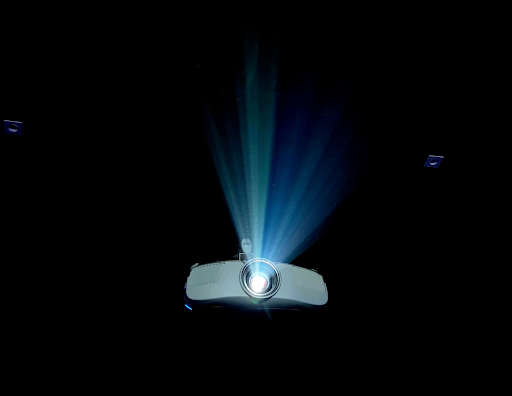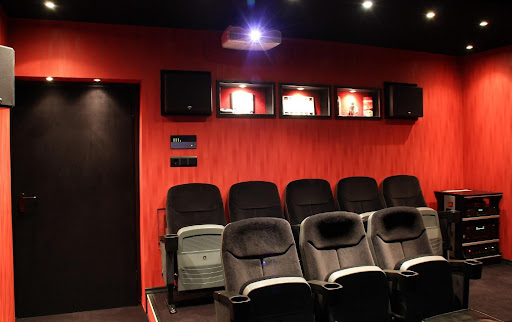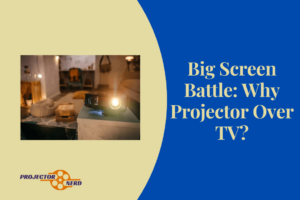Ambient light is an essential factor when it comes to a projector. Ambient light can make or break a projector’s viewing experience. 4K home theater projectors use various technologies and methods to manage ambient light.
You must pay attention to the nature of the lighting before buying a projector. So, the section below explains the relationship between ambient light and 4K home cinema projectors.
Contents
Home Theater Projectors 4K
Home cinema projectors help project an image to a screen or a surface using a light source. Good image quality, high contrast ratio, wide color gamut, etc., are the general features of a home theater projector.
4K home theater projector is a new addition to home theaters. They provide high-clarity images. They come with a high resolution of 3840 x 2160 pixels.
You can watch clear images from a distance with a 4K projector. They are the best projectors for living rooms, media rooms, home cinema rooms, etc.
There are two popular types of 4K projectors: 4K laser projectors and 4K DLP projectors.

4K Laser Projector Home Theater
A laser home cinema projector uses a primary-colored laser light source for projection. They also contain multiple lenses and chips.
4K laser technology is present in both portable projectors and permanent ceiling projectors. This device makes a high-quality picture on screens.
Some other factors that make it the best projector are:
- Maintains clarity even on a large screen.
- Uses their light output completely.
- Long-lasting than other projectors
- Operates at high speed.
- Works very well even with moderate ambient light
- Ambient light-rejecting versions are available.
4K DLP Projector
DLP, or Digital Light Processor, is a new home cinema technology based on chips. These projectors produce high-quality images. Pixels are arranged tightly in these projectors. So, the projected image will have accurate colors, high resolution, and high picture quality.
Some of the unique features of these projectors are:
- Operates much faster than the other projectors.
- Highly portable projector
- Best for low natural light situations
- Higher brightness
- High color accuracy even at night
Ambient Light
Ambient light is the light that is naturally present in a room or frame. Ambient light can be of two types: Natural source and manufactured light source.
Natural source primarily includes sunlight. Rooms with high exposure to the sun have high ambient light. Moonlight is also another form of ambient light from natural sources.
Manufactured sources include any types of artificial light fixtures present. They can be streetlights, permanent home lights, etc. But they should be present already in the room, not fixed for now.
Any extra light additions, modifiers, or lenses for recording or shooting a visual cannot be considered ambient light. Ambient light should purely be present at the location priorly.
Moderate ambient light is always suitable for a home theater. Because strong ambient light would make it difficult to see the projected image. So, the projectors would have to use ambient-light rejecting screens and high projector brightness.
The Importance of Ambient Lighting Control in Home Theaters
Home theaters need more than a simple ceiling light. You have to control the ambient light in the space and add more light sources if necessary.
Because if you do not control the ambient light, it could affect the viewing experience. High ambient light can overpower the screen and make it difficult for the viewer to identify the images.
It is always best to have moderate ambient light in your home theater. This helps you watch the videos with decent clarity both day and night.
The primary reason for high ambient light is the windows. So, if your home theater has high ambient light, it is better to cover the windows using a blackout curtain.
Another reason could be the color of the room wall. Walls with lighter shades of color can reflect light better, increasing the room’s brightness. It is better to use dark wall colors, which help limit ambient light.
You can use ambient light-rejecting screens if the ambient light is too bright. These projector systems contain a brighter projector with high image quality and a screen that optimizes the ambient light coming into it and help show more colorful and cool images with high resolution.

Different Types of Ambient Lighting and Their Effects on 4K Projectors
Ambient light can either be natural or artificial. But they should all provide general lighting, not any focus or spotlight.
Natural Ambient Light
Natural ambient light includes light from natural sources like the sun and moon. These play a significant role in the general lighting of any room. Depending on the positioning and the location of the room, the quantity of natural ambient light changes.
This type of light is not possible to change in any way naturally. You can use blockers, modifiers, lenses, etc., to increase or decrease the intensity of the natural ambient light. You can use blackout curtains to block the sunlight and use lenses to reflect them off.
This natural ambient light has high color accuracy. Being natural, they help show images with their true colors. But high natural ambient light can always affect the quality of the visuals.
Man-made Ambient Light
Manufactured ambient light includes artificial light sources like lamps, lights, etc. But they provide general lighting only. The best examples of artificial ambient lights are streetlights and general light sources in the home.
Home light sources can be anything from LED wall lights to floor lamps. Many of them are customizable too. But they should not be specifically designed for the home theater. Such light sources cannot be considered ambient light sources.

How to Choose the Right Screen for Ambient Lighting Conditions?
Usually, white screens are popular for projectors. But they reflect light and turn the room brighter. So, they don’t work well in rooms with high ambient light.
This is why ambient light-rejecting screens have become more popular now. These screens are made of a light-rejecting material. They help maintain the picture quality even in a bright room.
They are also helpful in showing the contrast of the pictures. Because when a white screen is used, the images look pretty washed out due to the bright natural light in the room.
You can view life-like images with high color accuracy and color contrast with ambient light-rejecting screens. These screens are usually dark grey.
The material in a light-rejecting screen makes sure they reflect light away from the audience. This creates a low-light sensation to the viewer, which helps them enjoy the visuals in a life-like manner.
Some of the essential things you want to check while buying a light-rejecting screen are:
Screen Color
Such screens are available in various shades of grey. So, you can choose the screen color according to the ambient light in your room, and how much light you want to block.
Projector Brightness
Depending on the room’s brightness and the projector’s brightness, you can choose the screen. If the projector has high brightness, the screen should be able to optimize the brightness.
The contrast of the Projected Image
The projected image’s contrast can vary according to the color of the screen. So, make sure to pick the right shade of light-rejecting screen, which helps show the true color contrast of the image.

Summary
Ambient light is essential for a home theater. Suppose you use a 4K technology home theater projector and have a room with high ambient light.
The screen could not show the images with the right quality due to the high ambient light. Thus, controlling the ambient light in a home cinema theater is essential for a better image-viewing experience.
You can use blackout curtains, blockers, etc., to reduce the ambient light. Reflectors, lenses, etc., are methods to increase ambient light.
But the best way to optimize ambient light is to use ambient light-rejecting screens. They adjust the images according to the incoming light. They help produce high-quality images.
FAQs
1. What is the best type of ambient lighting?
The best type of ambient light is warm light with reasonable lumens. Lumens are the basic unit to measure the brightness of a light source.
High lumens may not be suitable for the viewing experience. Having very low lumens is also not ideal. So, having enough lumens to provide decent visibility for the room is better.
A warm shade of light is more comforting to the audience. Using ambient color lights that you can adjust is suitable for creating a relaxing atmosphere.
2. Are LED lights ambient lighting?
LED lights can be ambient lighting. LED lights are available in different lumens. It is better to use LED light sources of low brightness to avoid washing out the image on the screen.
3. Are 4K laser projectors worth it?
A 4K laser projector is a device that provides a resolution of 3840 x 2160 pixels. It uses a laser light source to create an image. The high resolution gives high-clarity visuals.
These portable projectors offer high contrast and color accuracy along with high resolution.
4. How many lumens is good for a projector?
For home theaters, a minimum of 1500 lumens is ideal. Classroom and commercial projectors must have more lumens than home theater ones.

I’m Steven Berry and I’m the proud owner of an electronics store. With years of experience in the industry, I’m passionate about providing top-quality projectors to customers who want to take their entertainment or business presentations to the next level. Browse my store and let me help you find the perfect projector for your needs.



